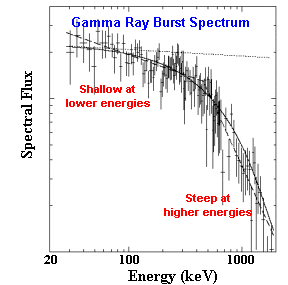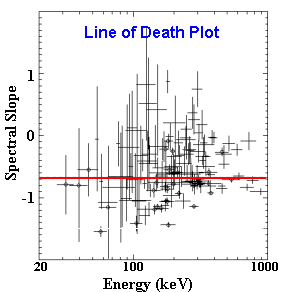 Space Science News home |
|
 Space Science News home |
|
|
October 13, 1998: Cosmic gamma-ray bursts have been called
the greatest mystery of modern astronomy. They are powerful blasts
of gamma- and X-radiation that come from all parts of the sky,
but never from the same direction twice. Space satellites indicate
that Earth is illuminated by 2 to 3 bursts every day. What are they? No one is certain. Until recently we didn't even know if they came from the neighborhood of our own solar system or perhaps from as far away as the edge of the universe. The first vital clues began to emerge in 1997 when astronomers detected an optical counterpart to a gamma-ray burst. In February 1997 the BeppoSAX X-ray astronomy satellite pinpointed the position of a burst in Orion to within a few arcminutes. That allowed astronomers to photograph the burst, and what they saw surprised them. They detected a rapidly fading star, probably the aftermath of a gigantic explosion, next to a faint amorphous blob believed to be a very distant galaxy. |
 The Burst and Transient Source Experiment (BATSE) aboard the Compton Gamma Ray Observatory, pictured above, has recorded over 2000 cosmic gamma-ray bursts since it began operations in 1991. |
 This image from the Hubble Space Telescope shows the optical afterglow from a gamma-ray burst detected in February 1997. The bright spot is thought to be an expanding fireball, and the weak diffuse emission (below and to the right) may be the distant host galaxy. |
Since then seven more optical counterparts have been discovered.
A recent discovery makes gamma-ray bursts seem more fantastic
than ever. Shri Kulkarni of Caltech and his colleagues found
that a gamma-ray burst recorded in December 1997 came from a
faint galaxy with a redshift of 3.4. That means that the burst
originated over 12 billion light years away. Kulkarni noted that
"The energy released by this burst in its first few seconds
staggers the imagination." Indeed, it was one of the biggest
explosions since the Big Bang itself. Now that we know where gamma-ray bursts come from -- very far away -- the next daunting task is to understand what causes them. In the absence of much hard data theorists have proposed a multitude of possible scenarios, from super-supernovae to mutually annihilating neutron stars. It is widely thought that the x-ray, optical, and radio afterglows might provide some clues. |
| The light curves of the few known optical and X-ray counterparts are consistent with that of an expanding fireball that is glowing because of a "Synchrotron Shock". The basic idea is that a tremendous explosion ejects a shock wave of material that accelerates charged particles, like electrons and protons, to velocities near the speed of light. Dr. Robert Preece, a gamma-ray astrophysicist at the University of Alabama in Huntsville, likened the shock wave to a wave on the beach. "A shock forms when the wave crest starts to fall over, and scud from the wave shoots out ahead." |
 A synchrotron shock wave can be visualized as an ocean wave. A shock forms when the wave crest starts to fall over, and scud from the wave shoots out ahead. In the cosmic shock wave, the 'scud' is composed of charged particles that give rise to synchrotron radiation. |
|
In the cosmic shock wave, the 'scud' is electrons and protons. They accelerate ahead of the wave and spiral around magnetic fields lines, producing a form of radiation called synchrotron emission. Synchrotron emission is seen all the time here on Earth as a blue glow in particle accelerators, and radio astronomers detect it coming from the Milky Way. |
 Fortunately, the Synchrotron
Shock Model makes a testable prediction. The spectrum of a typical
gamma-ray burst looks like the plot at the right. At lower energies,
i.e., less than a few hundred keV (kilo-electron volts), the
spectrum is fairly flat. A nearly horizontal line fits that part
of the spectrum fairly well. At higher energies the spectrum
is steeper. The Synchrotron Shock Model predicts that the slope
of the line that fits the lower energy part of the spectrum cannot
be greater than -2/3. Fortunately, the Synchrotron
Shock Model makes a testable prediction. The spectrum of a typical
gamma-ray burst looks like the plot at the right. At lower energies,
i.e., less than a few hundred keV (kilo-electron volts), the
spectrum is fairly flat. A nearly horizontal line fits that part
of the spectrum fairly well. At higher energies the spectrum
is steeper. The Synchrotron Shock Model predicts that the slope
of the line that fits the lower energy part of the spectrum cannot
be greater than -2/3. In a recently published edition of the Astrophysical Journal Letters Rob Preece and his collaborators from the University of Alabama examined over 100 bright bursts collected by the BATSE instrument on the Compton Gamma Ray Observatory and measured the slopes of their low-energy spectra. The figure at left shows their data.  They plotted the
slope of the low energy part of the spectra (vertical axis) vs.
the peak burst energy (horizontal axis). The red line is the
so-called "Line of Death", corresponding to a spectral
slope greater than -2/3. If a data point falls above the line,
that gamma-ray burst cannot have been caused by a synchrotron
shock, and thus the Synchrotron Shock Model is "dead"
for that burst. Preece et al. found that 44% of the bursts fell
above the Line of Death. If we assume that all gamma-ray bursts
are caused by the same thing, this means that none can be due
to a synchrotron shock. They plotted the
slope of the low energy part of the spectra (vertical axis) vs.
the peak burst energy (horizontal axis). The red line is the
so-called "Line of Death", corresponding to a spectral
slope greater than -2/3. If a data point falls above the line,
that gamma-ray burst cannot have been caused by a synchrotron
shock, and thus the Synchrotron Shock Model is "dead"
for that burst. Preece et al. found that 44% of the bursts fell
above the Line of Death. If we assume that all gamma-ray bursts
are caused by the same thing, this means that none can be due
to a synchrotron shock. Thanks to their work we now know another thing that gamma-ray bursts are not. They can't be caused by a synchrotron shock. Interestingly though, there is strengthening evidence that the optical counterparts, the glow from fireballs that appear to be the aftermath of gamma-ray bursts in distant galaxies, are caused by synchrotron shock waves. Whatever makes the fireball glow is apparently different from the mechanism that makes gamma-ray bursts. It's yet another mystery in the fantastic saga of gamma-ray bursters. |
| Web Links | |
|
More
science headlines -
NASA space science research Blasts from the Past - a review of recent gamma-ray burst discoveries Cosmic Gamma Ray Bursts - from Science@NASA |
Magnetars.org - all about magnetars and
soft gamma-ray repeaters BATSE Home Page The Synchrotron Shock Model confronts a 'Line of Death' - PDF preprint of the Astrophysical Journal Letter. Reference: Preece et al. 1998, ApJ, 506, L23 |
|
More  Headlines Headlines
return to Space Science News Home Author: Tony
Phillips |